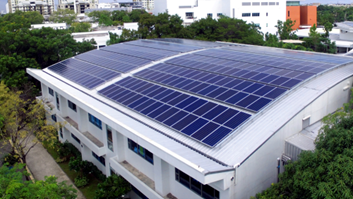Business Sustainability in 2025: The Power of Solar Panels, Energy Storage, and Smart EV Charging Stations
More and more companies are taking an integrated approach to sustainable energy. In the past, businesses might have only installed solar panels, but we now see a surge in systems that combine solar panels, energy storage solutions, and electric vehicle (EV) charging stations. This development is driven by both economic and social factors: companies aim to reduce energy costs, lower their carbon footprint, and position themselves as forward-thinking. In this blog, we discuss the main trends and benefits of this holistic approach to corporate energy management.

1. Solar Power as the Foundation
1.1 Solar Panels on Commercial Roofs
Solar panels remain the most accessible and visible way for businesses to generate their own clean energy. Many companies have underutilized roof space or parking lots—ideal spots for installing solar panels. With rising energy prices and falling solar technology costs, the payback period for a solar array is often just five to ten years, depending on subsidies and specific local conditions.
1.2 Additional Financial Advantages
Besides the direct savings on energy bills, businesses can benefit from various tax advantages and subsidies. Examples include the Energy Investment Allowance (EIA) in the Netherlands or Europe-wide incentives for renewable energy projects. These programs reduce overall costs, making the business case for solar panels even more compelling.
2. Energy Storage: Stability and Flexibility
2.1 Handling Peaks and Troughs
While solar energy can significantly meet a company’s electricity needs, it remains dependent on weather conditions and the day-night cycle. With a battery storage system, businesses can capture surplus energy produced during the day and use it at night or on cloudy days. This not only cuts energy purchase costs but also helps stabilize the overall energy supply.
2.2 Peak Shaving and Grid Congestion
Many companies face high peak demand charges or even grid congestion (limited available capacity on the local grid). By storing energy and using it during peak times, businesses can reduce their peak loads—a process often called “peak shaving.” In turn, this lowers the risk of incurring additional grid charges or delaying projects due to capacity constraints. Battery storage thus plays a key role in optimizing corporate energy management.
3. EV Charging Stations: A Growing Need
3.1 Electrifying the Fleet
Corporate fleets are rapidly going electric. Encouraged by tax incentives and stricter emissions targets, more and more businesses are adopting electric company cars and pool vehicles. Pairing these EVs with onsite solar energy for charging is an efficient way to maintain a sustainable fleet.
3.2 Smart Charging Technology
Smart charging stations can dynamically adjust charging power based on the amount of solar energy available or the company’s overall energy consumption to avoid overloading the grid. In some setups, part of the EV fleet can even feed energy back into the grid (known as Vehicle-to-Grid, or V2G), although this technology is still maturing and not yet widely available.
4. Integrated Systems and Benefits for Businesses
4.1 Cost Savings and Rapid Payback
By combining solar energy, energy storage, and EV charging stations, companies maximize the synergy between production, usage, and storage. Rather than selling solar energy back to the grid at a potentially lower rate, businesses can use that energy onsite or to charge their vehicles, which can lead to significant savings on energy bills. Investments in battery systems or charging infrastructure often achieve faster payback when the systems are integrated.
4.2 A Sustainable and Innovative Image
Customers, suppliers, and employees increasingly value corporate social responsibility. A company that visibly invests in green infrastructure—think solar carports, EV charging stations, and integrated battery storage—can position itself as an industry leader in innovation and environmental stewardship. This strengthens brand reputation and can even provide a competitive edge.
4.3 Reduced Dependence on External Factors
Onsite generation and storage make businesses less vulnerable to fluctuations in market electricity prices. This also lessens reliance on an often-overstretched grid, especially in regions with capacity constraints. A more reliable, predictable energy supply benefits the continuity of business operations.
5. Future Outlook and Considerations
Although solar technology, batteries, and charging stations are maturing, there are still key points to keep in mind:
- Regulation and Subsidies: Financial and legal frameworks for energy storage and grid feed-in can change. Stay informed about policy shifts to capitalize on available incentives.
- Technical Integration: It’s essential to ensure these different components work seamlessly with a company’s energy management system. Consulting with experts can help set up an effective “smart grid” onsite.
- Cost-Benefit Analysis: Even though battery and charging station prices are coming down, a thorough business case calculation is still necessary. Consider ongoing maintenance costs, system lifespan, and future expansion needs.
Conclusion
The trend toward integrated renewable energy systems—combining solar panels, energy storage, and EV charging—continues to grow and presents substantial opportunities for companies looking to cut their energy bills and bolster their green credentials. With the right subsidies, technological solutions, and alignment between systems, businesses can not only protect themselves against rising energy prices and shifting regulations but also take a major step toward a more sustainable future.
In short, businesses that invest in a holistic energy solution now will reap both financial and societal benefits in the years to come.
 Large stock of systems & materials
Large stock of systems & materials